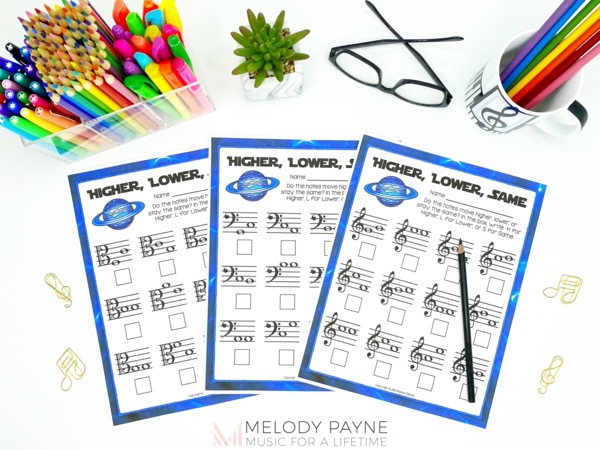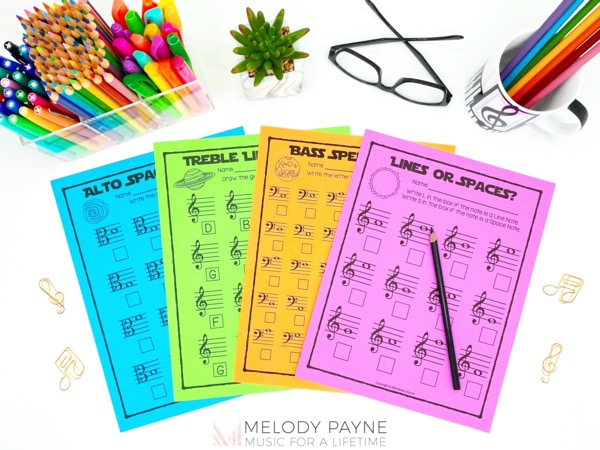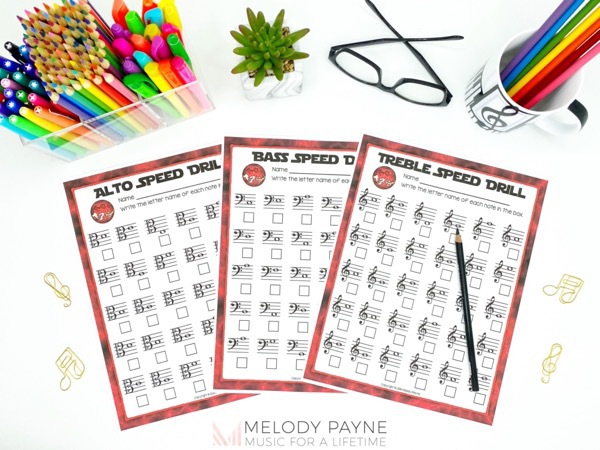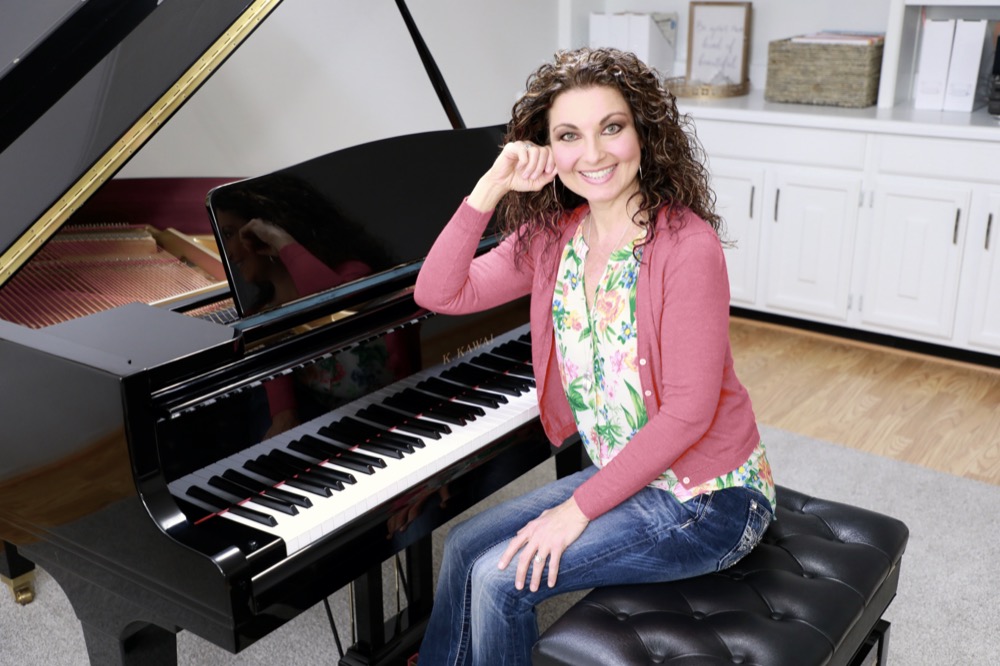5 Ways Staff Wars Beginner Theory Worksheets Benefit Your Piano Studio
This post may contain affiliate links. If you purchase something through an affiliate link, I will receive a small commission at no cost to you. For more information, read the disclosure statement here.

Do your beginning music students love Star Wars, Star Trek, or any other space-related movie or TV show?
The outer space theme really never gets old, does it?
So why not capitalize on your students’ interest in outer space by providing them with these space-themed beginner theory worksheets?
Call them “Staff Wars” and your students will smile and immediately understand the reference. Voila! Potentially boring theory worksheets are now “cool”!
What You Get
- 62 no-prep, no frills, print and go beginner theory worksheets to supplement a variety of music lessons
- Set includes both color and ink-friendly black & white versions of the worksheets
- Answer keys for everything
- You can’t go wrong for the price — for 62 space-themed treble, bass, and alto clef worksheets plus answer keys. Wow!
Let’s look at this resource in a bit more detail.

Staff Wars Beginner Theory Worksheets Part One: Starting Out
First, there are nine pages of “Higher, Lower, Same” worksheets, three pages for each clef.
Students have 12 opportunities per page to complete the given task. On some pages, they trace two notes on a mini staff, then circle the note that is higher.
On other worksheets in this section, students simply examine two notes and write “H” if they move higher, “L” if they move lower, or “S” if the two notes are the same. This is a fundamental skill and a perfect start!
Then, there are 15 pages of note-naming practice and basic lines and spaces identification practice.
There are five pages each of treble, bass, and alto clef activities.
In this set of worksheets, students do various tasks such as identify whether a note is a line note or a space note, trace space notes, trace line notes, or label different line and space notes.
Next is 20 pages of pure note-naming practice. There are three pages each of treble, bass, and alto clef activities.
Then, there are two sheets of Middle C position notes, two pages of C position notes, three sheets of G position notes, and four additional alto clef pages.
There are 16 notes to identify per page. Each note is placed on its own mini staff. That way, students can really focus on labelling just one note at a time.
Staff Wars Beginner Theory Worksheets Part Two: Continuing the Musical Journey
The next set of pages gives students an opportunity to draw notes on the staff.
There are nine pages in total, three pages for each clef. Some pages ask students to draw only line notes, others ask for just space notes, and some include line and space notes.
Finally, there are nine pages of speed drills, three pages for each clef.
Since they are designed as a speed test, it makes sense that there are more notes per page to name here as compared to any other section in this resource.
There are 30 notes per page for students to label as fast as they can.

And now, as promised, here are ….
Five Ways to Use Staff Wars Beginner Theory Worksheets
1. Evoke creativity in your students and have a space theme for a week in your studio.
Ever had a student come in to a lesson on May 4th and say, “May the force (or fourth) be with you?” The first time this happened to me at a lesson, I must confess I didn’t even know what the student was talking about.
After she explained it to me, I realized I wasn’t as immersed in pop culture as I perhaps ought to be.
That got me thinking, what if, during the whole first week of lessons in May, we had a “space week” in the studio?
These worksheets could become an integral part of that theme.
You could simply hand out selected worksheets for students to complete during the lesson, and leave it at that. Or, you could go all out and bedeck your studio with planets hanging from the ceiling, “space” music playing as students enter your studio, etc.
You could encourage students to come to their lesson dressed as their favorite character from space, ask them to improvise “space”-sounding music on their instrument, etc.
The sky’s the limit (pardon the pun). Of course, you, the teacher, would also have to dress up. 🙂
Does this special week have to happen only in the month of May? Not at all! You could hold a “space week” anytime, and your students would enjoy it just the same.
2. Assign the beginner theory worksheets to be done as homework.
This should be simple enough, as all music students need note identification practice, don’t they?
The fact that you can print out these sheets in black and white makes this option economical for you, the teacher.
If you happen to have some colored paper in your office, printing the worksheets on multicolored paper adds a bit of pizazz.
However, the color versions of these worksheets are phenomenal!
I highly recommend printing these out! In addition to the planets found at the top left corner of each page, the lightning-like borders in blue, yellow, purple, and red really add to their attractiveness.
Of course, any of these beginner theory worksheets can be sent online to students, students can complete them on their iPad, or they can print off the version of their choice at home (color or black and white).
Whether you teach online or in person, this is still a great option.

3. Run an in-studio note naming speed drill contest.
Pitch this to your students with great enthusiasm!
Choose some of these beginner theory worksheets to be used as a competition. The obvious choice would be the speed drills.
The teacher can time students who are at the same approximate level completing a selected worksheet or two.
Award a small prize to the person who correctly labels the notes the fastest!
4. Have some of these beginner theory worksheets available as a waiting room activity.
Keep your beginner students busy completing these worthwhile beginner theory worksheets while they are waiting during a sibling’s lesson.
You can decide whether to add an incentive for the completion of the worksheets or not.
5. Use the beginner theory worksheets as an assessment tool.
Depending on the level of your student, any of these pages could be used as an assessment.
Give your student a reasonable amount of time to complete a worksheet or two all by themselves during a lesson, and see how they’re doing.
These beginner theory worksheets are very attractive, yet nothing on the page is a distraction. Your students won’t even realize they are being tested.
Buy Staff Wars Music Worksheets today and watch your students’ theory skills improve with every worksheet they complete!
Looking for More Theory Worksheets?
- Check out these 4 sets of space-themed worksheets in the Staff Wars bundle!
- If you need even more theory worksheets for all ages, you’ll love the Music Worksheets Mega Bundle!
- Save Time With Over 200 Print-and-Go Music Theory Worksheets!
More themed piano lesson activities
- The Best One-Stop Shop Educational Resource For Halloween Games And Activities For Piano Teachers
- How I Use Easter Piano Worksheets To Conduct Spring Assessments For Beginners
- 12 Fabulous Springtime Color by Note Worksheets for Your Young Musicians
- Save Time With Over 200 Print-and-Go Music Theory Worksheets!
Don't miss out!
Follow on Facebook and Instagram, join the best Facebook group for piano teachers, and subscribe to the newsletter to get helpful teaching tips, resources, and tutorials delivered straight to your inbox every week.
Celeste-tina Hernandez
Celeste-tina Hernandez
Welcome!

Hi! I’m Melody Payne, a pianist and piano teacher, educational resource author, a fun-loving wife to the most wonderful and talented hubby I could ask for, and a lifelong learner who loves to share. I want to make your life as a music teacher easier by writing and sharing helpful and relevant music teaching articles, and by creating educational resources with your very own students in mind. If you are a parent who wants to enroll your child in piano lessons, I’d love for us to get started building those skills that can give your child a lifetime of musical enjoyment!

